External links
- Star Light title listing at the Internet Speculative Fiction Database
"Star Light" is a science fiction short story by American writer Isaac Asimov. It was first published in the October 1962 issue of Scientific American and reprinted in Asimov's 1968 collection Asimov's Mysteries .
Arthur Trent is a starship pilot and the young accomplice of Brennmeyer, an elderly and brilliant researcher. Brennmeyer has been planning a crime for thirty years. They have stolen a quantity of a valuable substance called krillium that is needed to build robots, and can be sold for millions on any civilized world. Due to the size of the galaxy and the lack of any central government, no cooperation between police of different planets is possible except for the closest ones. So, as long as they are far enough from the point of origin, no search shall be possible; nor shall there be any reason for the locals to believe that the krillium was illegally obtained.
Brennmeyer has compiled extensive data on stars and inhabited planets for many thousands of light-years around. He plans a randomly directed jump through hyperspace, which shall place them well beyond the reach of the police. Then, another jump shall be made toward the closest planet in Brennmeyer's database. (They shall jump randomly because the time required to compute an ordinary jump is long enough that the police would catch them before the computation was complete, and also because there shall be no chance of anyone knowing their destination.) He has engaged Trent to pilot their getaway ship, since he cannot do so himself. Trent, however, does not wish to share the wealth. He murders Brennmeyer with a knife and flees by himself, confident that the ship's automatic search-and-compare program shall locate a usable star and planet for him. He leaves all the evidence for the police to find, since he is sure that they shall not be able to catch him.
He makes the jump, then waits for the computer to match the local stars to its stored patterns, based on its selection of a bright, nearby star. Much time elapses, however, without a match being found. Trent realizes, to his horror, that the star must be a recent nova, which distorts the pattern into one that the computer shall never be able to find in its maps. He lacks the knowledge to override the search procedure, and his life support shall not last indefinitely. The story ends with Trent wishing that he had kept the knife.
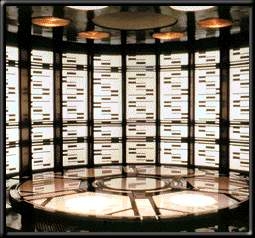
A transporter is a fictional teleportation machine used in the Star Trek science fiction franchise. Transporters allow for teleportation by converting a person or object into an energy pattern, then sending ("beaming") it to a target location or else returning it to the transporter, where it is reconverted into matter ("rematerialization").
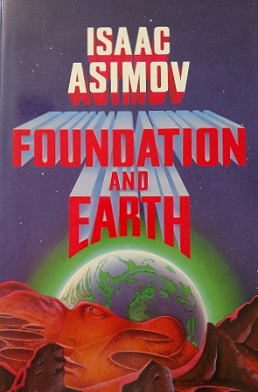
Foundation and Earth is a science fiction novel by American writer Isaac Asimov, the fifth novel of the Foundation series and chronologically the last in the series. It was published in 1986, four years after the first sequel to the Foundation trilogy, which is titled Foundation's Edge.
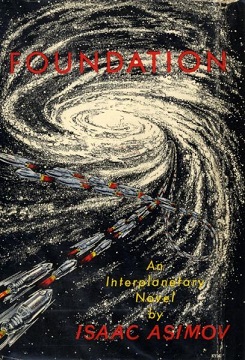
The Foundation series is a science fiction book series written by American author Isaac Asimov. First published as a series of short stories and novellas in 1942–50, and subsequently in three collections in 1951–53, for nearly thirty years the series was a trilogy: Foundation (1951); Foundation and Empire (1952); and Second Foundation (1953). It won the one-time Hugo Award for "Best All-Time Series" in 1966. Asimov later added new volumes, with two sequels: Foundation's Edge (1982) and Foundation and Earth (1986), and two prequels: Prelude to Foundation (1988) and Forward the Foundation (1993).

The Three Laws of Robotics are a set of rules devised by science fiction author Isaac Asimov, which were to be followed by robots in several of his stories. The rules were introduced in his 1942 short story "Runaround", although similar restrictions had been implied in earlier stories.

Nemesis is a science fiction novel by American writer Isaac Asimov. One of his later science fiction novels, it was published in 1989, three years before his death. The novel is loosely related to the future history of his Robot Series, Empire Series, and Foundation Series, into which Asimov attempted to integrate his science fiction output. This novel is connected to Asimov's other works by several ideas from earlier and later novels, including non-human intelligence, sentient astronomical bodies ("Hallucination"), and rotor engines.
Thiotimoline is a fictitious chemical compound conceived by American biochemist and science fiction author Isaac Asimov. It was first described in a spoof scientific paper titled "The Endochronic Properties of Resublimated Thiotimoline" in 1948. The major peculiarity of the chemical is its "endochronicity": it starts dissolving before it makes contact with water.
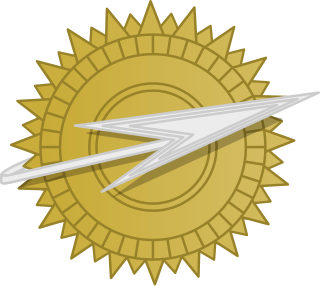
The Galactic Empire is an interstellar empire featured in Isaac Asimov's Robot, Galactic Empire, and Foundation series. The Empire is spread across the Milky Way galaxy and consists of almost 25 million planets settled exclusively by humans. For over 12 millennia the seat of imperial authority was located on the ecumenopolis of Trantor, whose population exceeded 40 billion, until it was sacked in the year 12,328. The official symbol of the empire is the Spaceship-and-Sun. Cleon II was the last Emperor to hold significant authority. The fall of the empire, modelled on the fall of the Roman Empire, is the subject of many of Asimov's novels.
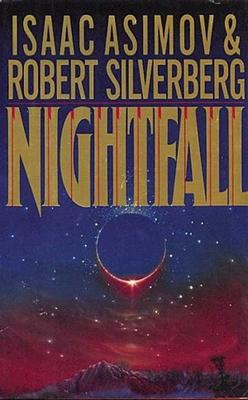
"Nightfall" is a 1941 science fiction short story by the American writer Isaac Asimov about the coming of darkness to the people of a planet ordinarily illuminated by sunlight at all times. It was adapted into a novel with Robert Silverberg in 1990. The short story has appeared in many anthologies and six collections of Asimov stories. In 1968, the Science Fiction Writers of America voted "Nightfall" the best science fiction short story written prior to the 1965 establishment of the Nebula Awards and included it in The Science Fiction Hall of Fame Volume One, 1929–1964.

Fantastic Voyage II: Destination Brain is a science fiction novel by American writer Isaac Asimov, published in 1987. It is about a group of scientists who shrink to microscopic size in order to enter a human brain so that they can retrieve memories from a comatose colleague.

Anacreon: Reconstruction 4021 is a video game written by George Moromisato for MS-DOS and published by Thinking Machine Associates in 1987. Anacreon is a turn-based game in which human and computer players explore the galaxy, conquering worlds and putting them to use to fuel their war machines. The game resembles Stellar Conquest and Hamurabi. It was inspired by Isaac Asimov's Foundation series of novels.
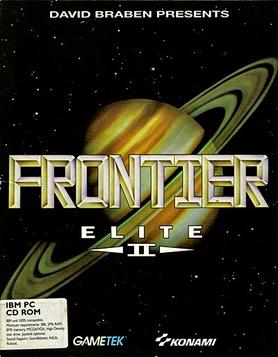
Frontier: Elite II is a space trading and combat simulator video game written by David Braben and published by GameTek and Konami in October 1993 and released on the Amiga, Atari ST and DOS. It is the first sequel to the seminal game Elite from 1984.
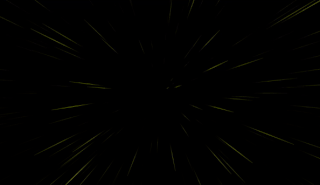
In science fiction, hyperspace is a concept relating to higher dimensions as well as parallel universes and a faster-than-light (FTL) method of interstellar travel. Its use in science fiction originated in the magazine Amazing Stories Quarterly in 1931 and within several decades it became one of the most popular tropes of science fiction, popularized by its use in the works of authors such as Isaac Asimov and E. C. Tubb, and media franchises such as Star Wars.

Reach for the Stars is a science fiction strategy video game. It is the earliest known commercially published example of the 4X genre. It was written by Roger Keating and Ian Trout of SSG of Australia and published in 1983 for the Commodore 64 and then the Apple II in 1985. Versions for Mac OS, Amiga, Apple IIGS, and DOS were released in 1988.
Battlestar Galactica is a fictional space battleship based in the science fiction television series of the same name. In the series, the Twelve Colonies built about 120 Battlestars during the thousand-year war with the Cylons, whose battleships are known as Basestars.
The Alliance–Union universe is a fictional universe created by American writer C. J. Cherryh. It is the setting for a future history series extending from the 21st century into the far future.

Cities in Flight is a four-volume series of science fiction novels and short stories by American writer James Blish, originally published between 1950 and 1962, which were first known collectively as the "Okie" novels. The series features entire cities that are able to fly through space using an anti-gravity device, the spindizzy. The stories cover roughly two thousand years, from the very near future to the end of the universe. One story, "Earthman, Come Home", won a Retro Hugo Award in 2004 for Best Novelette. Since 1970, the primary edition has been the omnibus volume first published in paperback by Avon Books. Over the years James Blish made many changes to these stories in response to points raised in letters from readers.

Isaac Asimov's Robot City: Cyborg is a 1987 novel by William F. Wu. It is part of the series Isaac Asimov's Robot City, which are inspired by Isaac Asimov's Robot series, and his Foundation novels.

Star Trek: The Promethean Prophecy is a text adventure game developed by Trans Fiction Systems and published by Simon & Schuster Software in 1986 during the 20th anniversary of the Star Trek: The Original Series. The game was developed by Ron Martinez and Jim Gasperini who also worked on Hidden Agenda. The player assumes the role of James T. Kirk captain of the USS Enterprise which has sustained heavy damage after being attacked by an unknown entity. A landing party headed by Kirk beams down to a nearby planet to find food for the ship's crew as the resources onboard became contaminated during the attack.

"Blockade" is the nineteenth and penultimate episode of the second season of the military science fiction television series Stargate Universe. The episode originally aired on May 2, 2011 on Syfy in the United States. The episode was directed by longtime director and producer of the Stargate franchise Andy Mikita. It was written by Linda McGibney.
The Foundation universe is the future history of humanity's colonization of the galaxy, spanning nearly 25,000 years, created through the gradual fusion of the Robot, Galactic Empire, and Foundation book series written by American author Isaac Asimov.